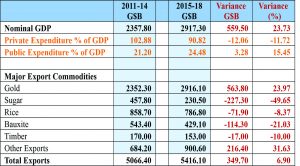In the previous week’s article, total public and private expenditure were examined over the period 2011-14 and 2015-18, which were disaggregated to show investment and consumption expenditure. To this end, the analysis revealed that private consumption fell by 8.68 per cent or $182.4 billion, while private investment increased by $406.2 billion or 125 per cent in the period 2015-18. This level of increase in private investment, as was contended, came largely from oil & gas-related activities in the economy where ExxonMobil, in particular, has injected billions of dollars into the economy to its sub-contractors for services utilised to service its operations.
On the other hand, total public expenditure increased by $214.2 billion or 43 per cent, relative to the corresponding period. Interestingly, however, public investment fell by $35 billion or 14.34 per cent in the period 2015-18 compared to the period 2011-14, while public consumption has increased dramatically by almost 100 per cent or $250 billion from $256 billion for the period 2011-14 to $505 billion – equivalent to the entire national budget for 2017 which was $250 billion. 
Today’s analysis focuses on a comparison of private and public expenditure as a percentage of GDP in nominal terms together with an examination of the major sectorial performances.
Towards this end, the data from the above table shows that total private expenditure for the period 2011- 2014 was almost 103 per cent of GDP which fell by 12 pe rcent or $12 billion to 91 per cent of GDP in the period 2015-2018. Conversely, public expenditure for the period 2011-2014 was 21.2 percent of GDP which increased to 24 percent of GDP in the period 2015-2018.
These outturns have actually further corroborated the arguments made in the previous articles – where it was contended that over the last four years, the private sector has actually shrunk compared to the previous four years, while the public sector has been growing steadily, noting that public consumption expenditure has undergone massive increases, with lesser allocation of financing towards public investments.
In other words, what has happened is that Government has managed to shrink the size of the private sector through its fiscal policies over the last four years – by increasing the level of taxations, rather than increasing the tax base collected from the private sector and consumers, which essentially finances government expenditure that is largely concentrated in consumption expenditure. This, in turn, has bloated the size of the public sector.
Turning now to the sectorial performances, an even more worrying trend has been revealed. The data in the above table has shown that over the last four years, export earnings from gold has actually increased by $564 billion or 24 per cent compared to the period 2011-2014. However, quite worryingly, Guyana has lost $227 billion or about 50 per cent of export earnings from sugar over the last four years relative to the previous four years period of 2011-2014, the rice sector has also recorded losses of 8 per cent or $72 billion in export earnings compared to the previous period 2011-14, $114 billion loss of export earnings from bauxite for the period 2015-18 relative to the corresponding period, and, a loss of $17 billion or 10 per cent of export earnings from timber, giving rise to a combined loss of export earnings of a whopping $430 billion or the equivalent of about US$2.1 billion over the last four years period of 2015-2018 compared to the period 2011-2014.
Next week, a summary of the findings from the analyses done over the last few weeks’ columns will be presented with an overall conclusion & recommendation section.
